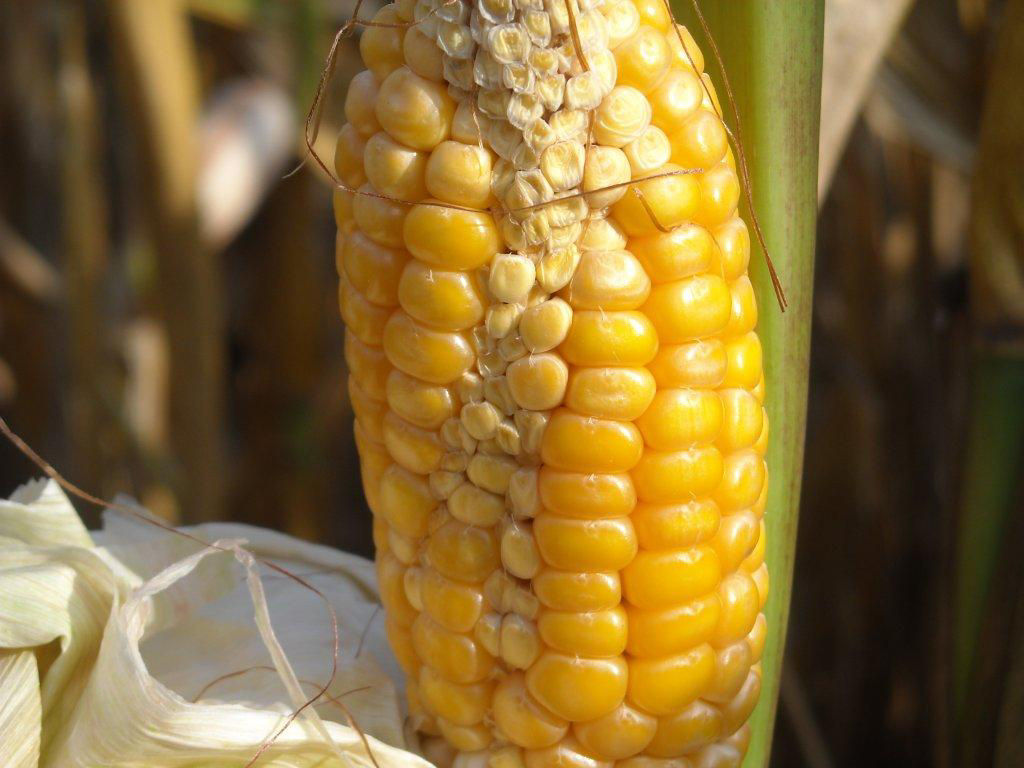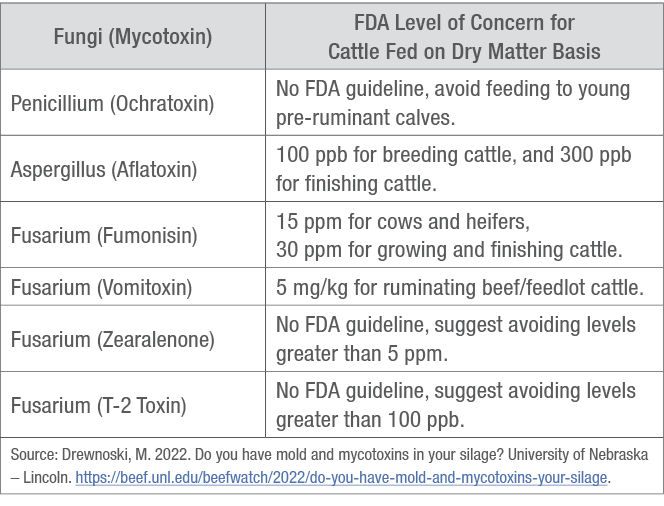Silage Stress Factors and Effect on Quality and Digestibility
March 11, 2024
- Environmental stress can reduce leaf area and grain production of any crop, but stressed corn silage fields are scrutinized for feed value.
- Fiber digestibility and starch content are altered by abiotic stresses like drought, early frost, heat, and hail.
- Infections from fungal pathogens can reduce dry matter and produce mycotoxins dangerous to livestock.
Drought
The effects of drought on silage yield depend on the timing of the stress during crop development. Drought stress during pollination reduces grain production, sometimes resulting in earless corn. Earless corn silage, or low grain silage, has greater fiber and less starch content than normal corn silage. Depending on the amount of drought stress, the energy value of drought-stressed silage may be 5 to 10 percent less than non-stressed corn because of a stress-induced reduction in starch content that is only somewhat compensated for by an increase in the digestibility of the fiber.1 Fiber digestibility increases because lignin production in cell walls is typically reduced in drought-stressed corn.2 Late-season drought stress may not increase fiber digestibility if grain production was low and large stalks were already well developed with lignin. A nutritionist could re-balance rations to reach effective fiber amounts with by-products during drought years with reduced silage yields.
Drought-stressed corn may have concentrated nitrate in lower stalks. High-nitrate silage can poison livestock, especially in lower-energy rations. Rainfall increases the uptake of soil nitrogen, which increases nitrate concentration, so harvest should be avoided within three days of rainfall on drought-stressed corn.3,4 High chop silage (increased cutting height) reduces the risk of harvesting nitrate that is concentrated in the lower stalks; however, this practice reduces yields. Fermentation can reduce nitrate levels nearly 50 percent and is the reason ensiling is preferred over green chop when stalks have high nitrate levels.4 However, the silage must be ensiled for 21 day to effectively reduce nitrate levels.5

Early frost
An early frost event could affect corn intended for silage. When a light frost event occurs and some leaf tissue remains green, corn regrowth may add dry matter accumulation. Corn killed by frost at an immature stage should be left in fields until appropriate moisture levels are reached for ensiling. In the case of a horizontal silo, wait until the field is at 72 percent whole-plant moisture before harvest.4 Careful harvest timing is again the key management practice after frost, as dry matter and harvest losses can increase during field drydown.
Heat
Hot weather after pollination interferes with starch synthesis in kernel embryos. Temperatures higher than 95 °F can cause up to a 75 percent reduction in dry matter accumulation compared to corn developing in 77 °F temperatures.6 Low dry matter yields are often attributed to drought conditions. However, untimely heat stress has been shown to be the dominating negative influence on yields when rainfall is similar between two locations. Lignin production in cell walls is enhanced by heat stress. As heat stress increases lignification at the cellular level, fiber digestibility decreases.7
Because heat stress can cause plants to look rolled and dry, moisture testing should guide harvest decisions. When forages are harvested too dry, mycotoxins can be produced in storage. But when harvested too wet, silage can leach nutrients.
Leaf Area Reduction from Hail and Disease
Brown leaves remaining after a hail event can make plants look drier than they should given the measured moisture content. The ear and lower stalk are sometimes the largest remaining portion of a plant if the leaves and upper stem have been destroyed by hail.8 In this case, grain (starch) content is greater compared to forage. Depending on how many leaves have been stripped by hail, the forage portion would be made up of mainly stalks, decreasing the digestibility of the silage.

Damage to ears from hail, insects, and birds create openings for fungal pathogens. Silage is the better harvest option compared to earlage or high moisture corn when ears have mold growth. Fermentation in the ensiling process stops mold growth; however, mycotoxins already produced in field remain through the ensiling process and affect feed quality (Table 1). The fungal pathogens Fusarium spp., Gibberella, Penicillium, and Aspergillus are molds able to produce secondary metabolites such as mycotoxins. Environmental conditions, not mold count, determine mycotoxin levels.9
Table 1. Mycotoxin levels for cattle feed.

Stalk Stress
Weakened stalks can be the result of a myriad of stresses leading to stalk cannibalization. As carbohydrates are remobilized during grain fill, stalks become more susceptible to infection by fungal pathogens. Stalk rots caused by fungi lead to lodging, harvestability issues, and reduced dry matter. If fungicides labeled for corn silage are used, growers need to pay close attention to the label for pre-harvest interval information.
Wildfire Smoke
Reduced solar radiation and increased ozone are the primary concerns from wildfire smoke for corn growers. Smoke from a wildfire reduced the average solar radiation in Indiana by 32% during one week in 2023.10 This reduction is caused when incoming sunlight is reflected by smoke in the air, reducing the amount of light that would otherwise reach plants. These sunlight reductions can affect some crops more strongly than others. For example, corn – which uses the C4 photosynthesis pathway – is more susceptible to decreased sunlight than soybean or wheat, which both use the C3 photosynthesis pathway. Additionally, ozone can be formed from pollutants in wildfire smoke, and it damages plant tissue as plants absorb it during respiration. The potential for corn to experience negative effects increases when wildfire smoke occurs during grain fill stages. Silage affected by waves of wildfire smoke should be monitored for reduced grain production and stalk weakness. See the article https://www.cropscience.bayer.us/articles/bayer/wildfire-smoke-on-crops for more information.
Conclusion
Stress from the environment and disease reduces silage yield and has various other detrimental effects, but harvest can be timed to lock in appropriate neutral detergent fiber and moisture for digestibility and storage quality, respectively. Once ensiled and properly stored, silage does not change. Consider separating silage feedstocks by quality and feeding any lower quality silage to older heifers, late lactation cows, or dry cows.
Sources
1Adams, D. and Salfer, J. 2021. Feeding dairy cattle in a drought. University of Minnesota. https://extension.umn.edu/pasture-based-dairy/feeding-dairy-cattle-drought
2 Roth, G.W. 2010. Weather effects on corn silage. Spectrum Analytics. https://www.spectrumanalytic.com/doc/library/articles/weather_effects_on_corn_silage
3Coulter, J. 2021. Harvest strategies for corn silage. University of Minnesota Extension. https://extension.umn.edu/corn-harvest/harvest-strategies-corn-silage
4Roth, G.W. and Heinrichs, A.J. 2001. Corn silage production and management. Pennsylvania State University. https://extension.psu.edu/corn-silage-production-and-management
5Rasby, R. and Anderson, B. Options for drought damaged corn fields. University of Nebraska – Lincoln, UNL BEEF. https://beef.unl.edu/cattleproduction/droughtdamagedcornfields
6Ferreira, G., Behl, H.D., Hokanson, E., Thomason, W.E., and Teutsch, C.D. 2015. The interaction of drought stress and heat stress as determinant of dry matter yield and nutritional composition of maize (Zea mays L) whole-plant for silage. Conference: 2014 ADSA-ASAS-CSAS Joint annual meeting. Virginia Polytechnic Institute and State University. https://core.ac.uk/reader/230662120
7Ferreira, G. and Brown, A.N. 2016. Environmental factors affecting corn quality for silage production. In T. da Silva and E.M. Santos, Eds. Advances in silage production and utilization. InTech. doi: 10.5772/64381
8Drewnoski, M. 2023. Making silage from late season hail damaged corn. University of Nebraska – Lincoln, UNL BEEF. https://beef.unl.edu/beefwatch/2023/making-silage-late-season-hail-damaged-corn
9Drewnoski, M. 2022. Do you have mold and mycotoxins in your silage? University of Nebraska – Lincoln, UNL BEEF. https://beef.unl.edu/beefwatch/2022/do-you-have-mold-and-mycotoxins-your-silage
10Quinn, D. 2023. How does wildfire smoke impact corn growth? Purdue University. https://extension.entm.purdue.edu/newsletters/pestandcrop/article/how-does-wildfire-smoke-impact-corn-growth/
1227_357706
Seed Brands & Traits
Crop Protection
Disclaimer
Always read and follow pesticide label directions, insect resistance management requirements (where applicable), and grain marketing and all other stewardship practices.
©2024 Bayer Group. All rights reserved.